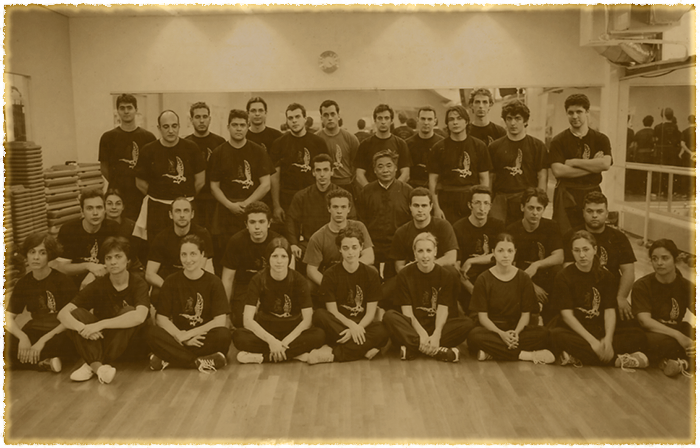 Ying Shou Quan (Hand of the Eagle), otherwise known as Ying Zhao Quan (Eagle Claw), is one of the most popular traditional styles of Chinese wushu, originating from a combination of two systems: Yue Shi San Shou and Fan Zi Quan. Today, it is also known as Ying Zhao Fan Zi.
Ying Shou Quan (Hand of the Eagle), otherwise known as Ying Zhao Quan (Eagle Claw), is one of the most popular traditional styles of Chinese wushu, originating from a combination of two systems: Yue Shi San Shou and Fan Zi Quan. Today, it is also known as Ying Zhao Fan Zi.
At the heart of Ying Shou Quan are the “Fifty Roads of Lian Quan” (Fifty Roads of the Connected Fist), which are 50 combat techniques that can be executed either individually or together, creating one long form (Taolu). The Yue Shi San Shou system, which is accredited to General Yue Fei, is the core of the “Fifty Roads of Lian Quan”.
According to legend, Yue Shi San Shou was created by the renowned General Yue Fei (1103 – 1142), an enthusiastic patriot with great skill in commanding an army, as well as in hand-to-hand combat, who lived during the Northern Song Dynasty (960 – 1127). He created a practical and most efficient combat style with emphasis on grabbing and locking, based on the nine basic techniques that he learned from the monk Li Quan. This style, which he taught to his soldiers, was later named Yue Shi San Shou, meaning “Combat Techniques of General Yue” or “Yue Shi Ying Shou”, meaning “Hand of the Eagle of Yue”. Following the treason and death of Yue Fei, legend has it that his soldiers dispersed across China and secretly taught the system.
Apart from the aforementioned legend, a different version exists, in which the monk Li Quan is said to have been a Fan Zi teacher who lived during the Ming Dynasty (1368 – 1644). Upon seeing the efficiency of Yue Shi San Shou in battle, he decided to train in both systems and eventually combined them to create a single system. While these legends may be true, no historical evidence has been provided that can directly connect General Yue Fei with the system of the eagle or can pinpoint the exact role of the monk Li Quan in the development of the system. Many years later, during the Ming Dynasty, General Qi Ji Guang wrote a book (published around 1562) in which he mentions the “grab of the eagle king” in a chapter about combat styles of the era. His book is considered one of the most important works about combat strategy and wushu, and is proof that the system of the eagle was already known at the time. In the same book, General Qi Ji Guang also refers to the Ba Shan Fan style, which is another name for the Fan Zi Quan style, placing it among the most effective combat styles of the Ming Dynasty period.
Unfortunately, there is little evidence of how the system evolved up to the end of the Qing Dynasty and therefore real facts get mixed together with legend. Nevertheless, according to spoken accounts of the teachers of our family and the written works of the great teacher Chen Zi Zheng Quan Shu Cai Yao (Synopsis of Martial Arts) published in 1917 and his notes referring to the technique, which were salvaged by his students, the teaching of Yue Shi San Shou was done in secret until the end of the Qing Dynasty. It was during the rule of Emperor Tong Zhi (1861 – 1875), when Liu Shi Jun inherits the style from the monks Dao Ji and Fa Cheng and begins teaching it in public.

Consequently, Liu Shi Jun is considered first in the genealogical line of the eagle, which extends to present day. Liu Shi Jun taught Liu Cheng You, who was a Fan Zi teacher that instructed his third son Liu Qi Wen and his nephew Chen Zi Zheng. Continuing the work of previous teachers, Chen Zi Zheng completed the combination of the Yue Shi San Shou and Fan Zi styles, creating the Ying Zhao Fan Zi system we know today. By meshing the best elements of both styles, he developed the “Ten Roads of Xing Quan” and the “Fifty Roads of Lian Quan”, two new forms that contain the epitome of the traditional eagle system.
Teacher Chen Zi Zheng left his mark not only on Ying Shou Quan, but also the entire modern history of Chinese martial arts, gaining the title “King of the Eagle”. Thousands of students were initiated into the beauty of the “eagle”, though only few were his personal students. One of those who managed to comprehend the essence of the art was teacher Guo Cheng Yao, father of teacher Guo Xian He, who is my teacher.
Panagiotis Derventis
